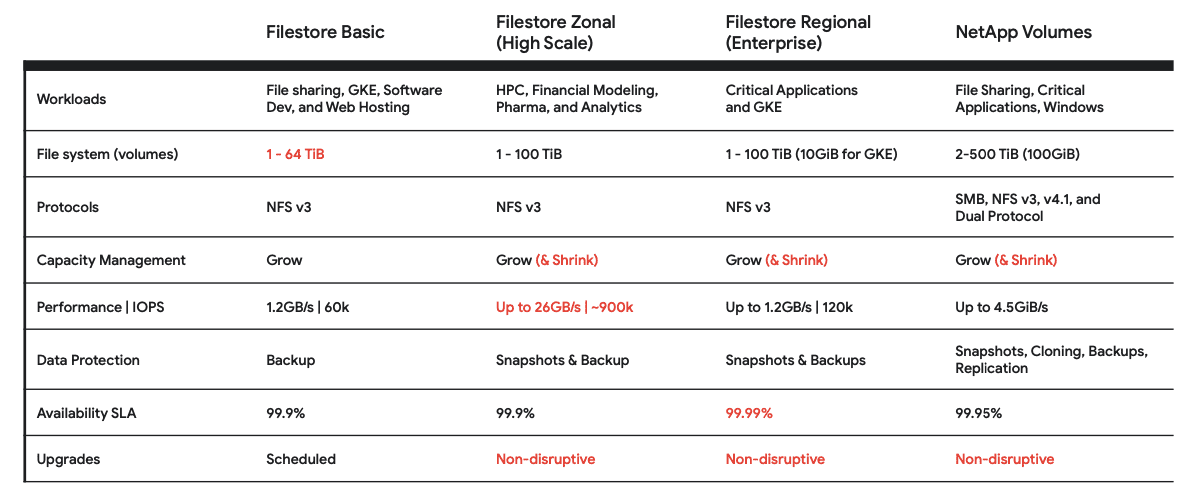NetApp and Google Cloud have jointly announced that NetApp’s ONTAP file system will now be available as a native storage solution in GCP. This completes the triumvirate of major Western public cloud services to get ONTAP as a primary storage platform.
Background
NetApp first announced the availability of Cloud Volumes Service in May 2018. Five years later, in conjunction with Google Cloud, the ONTAP file system will now be available as a first-party native offering in GCP. The new service – Google Cloud NetApp Volumes, or GCNV, provides native integration into GCP security, workflow and other processes.
This announcement is the latest in a succession of solutions that deliver ONTAP right into the heart of public cloud infrastructure. Amazon FSx for NetApp ONTAP was announced in September 2021, while Azure NetApp Files reached GA in June 2019.
Compatibility
In defining GCNV as “cloud-native”, what we mean is the functionality of ONTAP is delivered as a native part of the Google Cloud infrastructure. This means, for example, that security constructs and APIs within GCP will deliver the GCNV capabilities as part of the ecosystem. The ONTAP software isn’t running in a virtual machine or other workaround implementation. See this blog post, where we talk about the idea in more detail, and this one (here) where we talk about why APIs are needed for storage in the public cloud.
The distinction between having cloud support (for example, as a VSA) and being cloud-native is that GCP handles the back-end management of the platform. Google delivers upgrades, scalability, data resiliency and internal replication as a fully-managed service.
For the customer, GCNV operates as just another file service alongside the three other Filestore solutions, with the added benefit of the familiarity of ONTAP and the capability to move data natively in and out of the platform with features like SnapMirror. Last year we trialled FSx for ONTAP with SnapMirror to an on-premises filer, and it works but is a little clunky to set up.
Filestore
GCNV isn’t the first integration exercise from the GCP storage team. We believe that Elastifile, which was first available on GCP in December 2018), and then acquired by Google in July 2019, was used to deliver either Filestore Enterprise and/or Filestore High Scale. Google now has four file service offerings, alongside block and object options.

Build, Buy, Fork or OEM?
A storage platform is a complex solution to build from scratch, so acquisition (e.g. Elastifile) is a quick route to getting services up and running. Forking an open-source product is another option, but there aren’t many fully featured open-source storage platforms to choose from. Expanding on our post from 2019, OEM should be added as a fourth option, which is what we’ve seen from AWS, Azure and now Google. This enables all three cloud providers to stay in synchronisation with the main ONTAP code while providing customers an on-ramp into the cloud for their data. Bear in mind also that ONTAP has decades of evolution and so can provide enterprise-class reliability.
The Architect’s View®
We’ve been here before with previous NetApp announcements. The GCP implementation is another step towards providing customers with cloud platform choice. However, as we discussed in a blog post just last week (subscription required), NetApp annual recurring revenue (ARR) from the public cloud has stalled and been flat for the last 12 months. You can learn more about the background to this in our X-Ray eBook covering NetApp (available here, subscription required).

X-Ray: NetApp, Inc.
This Architecting IT report takes a deep dive into NetApp’s history, products, services, financials and future outlook. This report is only available for download via paid subscription.
We don’t believe that the GCNV announcement will do much to improve this situation. GCP has around 10% of the public cloud market, so the additional revenue will be marginal. There’s also a question as to whether extending to smaller cloud vendors would be worth the engineering work (Oracle and IBM Clouds, for example). However, NetApp and GCP are offering choice, and for Google in particular, this new solution offers a way for customers to move data relatively easily into GCP.
Despite the hard work involved, GCNV is a box ticked for the NetApp team – and not a lot more.
Copyright (c) 2007-2023 – Post #6a22 – Brookend Ltd, first published on https://www.architecting.it/blog, do not reproduce without permission. NetApp is a Tracked Vendor for Data Storage, Data Protection and Cloud Storage solutions.

